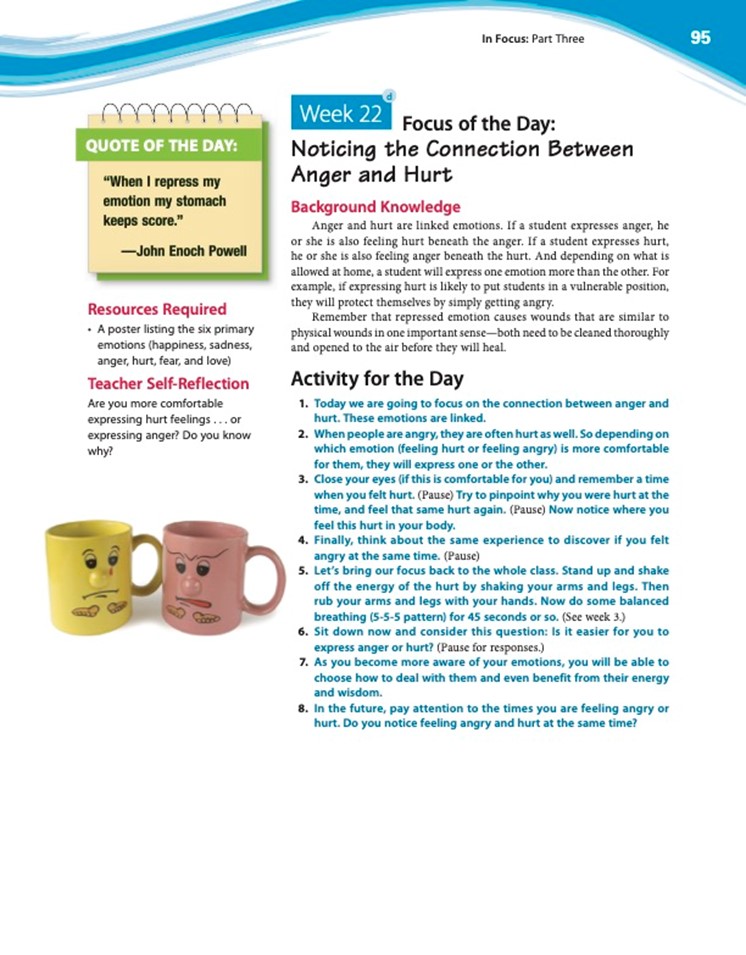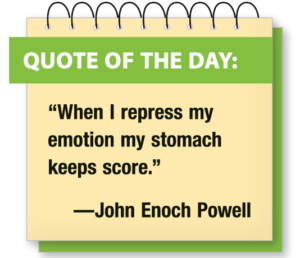Hurt and anger are paired emotions. When a student feels angry, she or he is also feeling hurt. Conversely, when a student feels hurt, she or he is also feeling angry. And consider the student’s home experience as well. Certain households tolerate an expression of hurt feelings but forbid anger, so the child “denies” being angry and expresses hurt feelings instead. Other households accept expressions of anger but tease the child with hurt feelings, so that child “denies” feeling hurt and expresses anger instead. Anger and hurt are linked emotions. If a student expresses anger, he or she is also feeling hurt beneath the anger.
Remember that repressed emotion causes wounds that are similar to physical wounds in one important sense—both need to be cleaned thoroughly and opened to the air before they will heal.
Preteens and teens will set you up to feel what they feel. They want to be understood and recognized and will often express their emotions in intense ways, until the teacher finally connects with them and understands what they are feeling. Being heard and understood can help your students regulate and soothe their strong emotions.
When we do not deal with our emotions or allow them to move in healthy ways, they can get stuck. This can cause physical pain as well as hinder our ability to resolve conflicts. Teaching students to be aware of where they feel hurt in their bodies gives them the opportunity to attend to the hurt rather than express it as anger.
Let’s focus in this blog on teaching a lesson on anger management for middle school students. This lesson comes from my In Focus SEL curriculum that I created.
Here is a picture of an In Focus SEL lesson plan on anger management. See below for the different parts to the lesson.

Noticing the Connection Between Anger and Hurt

Background Knowledge
Anger and hurt are linked emotions. If a student expresses anger, he or she is also feeling hurt beneath the anger. If a student expresses hurt, he or she is also feeling anger beneath the hurt. And depending on what is allowed at home, a student will express one emotion more than the other. For example, if expressing hurt is likely to put students in a vulnerable position, they will protect themselves by simply getting angry.
Remember that repressed emotion causes wounds that are similar to physical wounds in one important sense—both need to be cleaned thoroughly and opened to the air before they will heal.
Activity for the Day
- Today we are going to focus on the connection between anger and hurt. These emotions are linked.
- When people are angry, they are often hurt as well. So depending on which emotion (feeling hurt or feeling angry) is more comfortable for them, they will express one or the other.
- Close your eyes (if this is comfortable for you) and remember a time when you felt hurt. (Pause) Try to pinpoint why you were hurt at the time, and feel that same hurt again. (Pause) Now notice where you feel this hurt in your body.
- Finally, think about the same experience to discover if you felt angry at the same time. (Pause)
- Let’s bring our focus back to the whole class. Stand up and shake off the energy of the hurt by shaking your arms and legs. Then rub your arms and legs with your hands. Now do some balanced breathing (5-5-5 pattern) for 45 seconds or so. (Breathe in for 5 seconds, breathe out for 5 seconds, pause for 5 seconds.)
- Sit down now and consider this question: Is it easier for you to express anger or hurt? (Pause for responses.)
- As you become more aware of your emotions, you will be able to choose how to deal with them and even benefit from their energy and wisdom.
- In the future, pay attention to the times you are feeling angry or hurt. Do you notice feeling angry and hurt at the same time?
Resources Required
- A poster listing the six primary emotions (happiness, sadness, anger, hurt, fear, and love)
Teacher Self-Reflection
Are you more comfortable expressing hurt feelings . . . or expressing anger? Do you know why?
If you would like more information about my In Focus SEL curriculum click the link below.
https://teachingheartinstitute.com/in-focus-sel-curriculum/
If you want to stay connected to my social emotional work with teachers, parents, and coaches, click the link below and let me know that you want to receive my Teaching Heart Institute newsletter.
https://teachingheartinstitute.com/contact-tom/
Tom McSheehy, MSW, LSW, taught elementary and middle school for 21 years and has been a licensed social worker for 26 years. Tom is the author of In Focus SEL curriculum and has been working in the area of social emotional learning (SEL) for 36 years.




